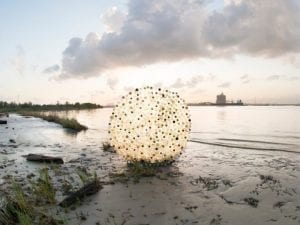Nadim Samman is a curator and art historian based in Berlin. He co-founded the first Antarctic Biennale, and has curated for the Marrakech Biennale, Thyssen-Bornemisza Art Contemporary and, currently, KW Institute for Contemporary Art, Berlin. He is a recent winner of Royal College of Art’s International Awards for Art Criticism, receiving the accolade for an article exploring the work of Jonny Niesche. As the prize calls for entries for 2020, Samman reflects on the power of arts journalism today.
A: What is the value of arts criticism in today’s world?
NS: Questioning the value of art criticism means asking “where are we in history?” Good criticism helps us navigate the morass of truth and image in the digital age, our entanglement in ecological crises, changing visions of identity and more.
A: Do you think arts journalism has the power to change perspectives?
NS: Mainstream art journalism is still quite influential in the UK. However, the editorial imperative for a news hook can push discussion towards banality (‘How much money did that cost?’). For years, this has played out in reporting on the YBAs, Banksy and the Turner Prize. The cumulative effect is that non-specialists often consider themselves very informed about the vacuity and cynicism of contemporary art, when, in fact, they are hearing about same shallow topics again and again. In this situation, “news” is too narrowly defined, limiting perspectives on art in general.
If people only hear that art is corrupt and stupid then how can they not feel alienated? I believe that art is the name set aside for things much better than this. Art is the place where muses like imagination, intelligence and generosity are supposed to dwell. If you do not see them, look harder! Writers and readers who expect something more – should widen their search, or else create what is missing.
A: How important are awards such as IAAC? What sort of impact can they have on writers and the wider industry?
NS: Public recognition and monetary support are crucial for sustaining art criticism and the space of public discourse that it holds open. Beyond its cooption as PR, or tabloid fluff, it is rarely given the support it deserves. This award is a wonderful way of valuing intellectually ambitious writing outside of academia.
A: What did it mean to win IAAC’s First Prize in 2019?
NS: Recognition feels great, and even better with a monetary prize. Working freelance means always looking for the next commission. There is no sitting back and resting on your laurels, no matter how tired you are. When I received the award I was a new father, and the money helped me take time for my family.
A: What was the subject of your winning piece?
NS: I wrote about the Australian artist Jonny Niesche, whose minimal paintings reference cosmetics, the cosmos and the queer gaze. It was about what his art wants with you, and the self-creating dimension of artifice. Niesche’s work is a compelling example of formal practice that sustains deeper meditation. Its apparent emptiness allowed me the space to think through narcissism and its glow.
A: Do you have any advice for aspiring writers or art historians?
NS: Do not style your writing as if it were crudely translated from another language. This is a common vice in para-academic “theory”. Read as much as you can. Certainly, more than you write.
Keep writing. Not every text will be a masterpiece. Though you should always do your best, it is important to let essays out into to the world before you kill them with too much kindness. Too many texts that are “nearly finished” disappear into oblivion when new essays are begun, awaiting further review. Vanity! The passion that one has for a certain project often has a use-by date. The same applies to the urgency of subject matter.
A first draft should be written as if you were speaking to an intelligent friend, in everyday language, without stopping to re-read each sentence along the way. The second pass is the time for increased logical precision and getting bogged down in the details. Being relaxed about the first will ensure the verve and rhythm of your thought carries through in your final text.
IAAC 7 is open for entries until 20 December. The award accepts entries of writing in Chinese or English about any contemporary art exhibition held anywhere in world or, for the first time this year, online. Find out more here.
Image: Mutual Vibration, installation by Jonny Niesche. Photograph: Ashley Barber.





